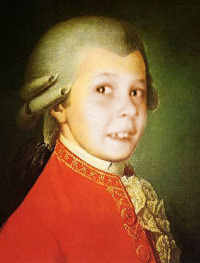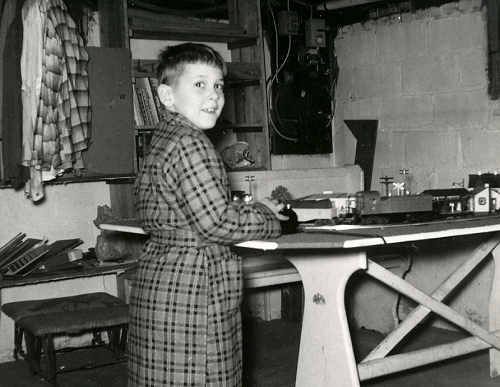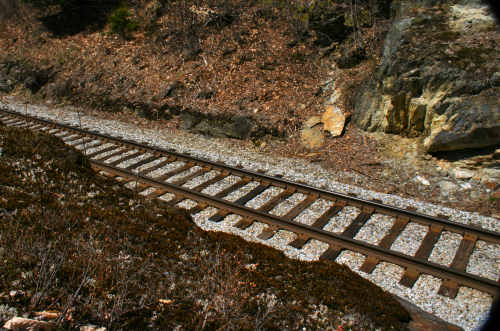A 365-Day Project
"We Are All Mozart"
A project to create
new works and change
the perception of the
music of our time.


 June 8, 2006
June 8, 2006 
I love trains. A recent conversation castigated electroacoustic composers for using trains and Tibetan prayer bowls. Tibetan prayer bowls? Enh, okay. But trains!
The discussion was talking about the clichés of electroacoustics. Perhaps for those who listen in an occasional way, a train is a train. Crossing bell, whistle, rumble. To me, there are no clichés among trains. Each experience is particular. The whistles (most of them unique in the United States), the sounds of metal against metal as the trucks roll along carrying their cars-of-burden, the diesel roar and subsonic shake, the disturbed air thundering past the ears, the engine's bell and crossing bells clanging their almost-even rhythms to different drummers.
The sound of a train appears in only one piece of mine, unaltered, as the Amtrak reached the high point on the line from Montreal to Miami, screaming through the little town of 330 where I experienced my first compositional oblivion, captured by the stereo microphone placed directly in its path, its cable wound through the ties and over the gravel and under the rail, soon sprayed with oil, but capturing just in time a fragment of that spatial roar so that it might resound as part of Echo. (I love fireworks and car horns, too.)
Beyond that one appearance, the train is too particular a set of sounds, too rich and wide and deep for transmutation in the electroacoustic world. Like my composer colleague Steve Gryc, who records geysers and mudpots but leaves them untransformed, I cannot bring myself to alter trains' sounds with my puny imagination. Too young for the age of steam, I still marvel at these grand machines and their personalities -- each engine different, each car marked and dented and graffitied through a personal history that makes it come alive and want to tell its story.
And the whistles. I'm told that in Canada, all the whistles are the same. But here! I wait for a hint of the sounds, the anticipation and the echo, the throat and the cry and the outbreathing. Sometimes I even know the engines that call with them. That inverted perfect third chord on 6506. I wanted to memorize that number. I learn of dopplers but do not care. Yes, it's a childhood imprint, all this.

My first trainset, a Lionel that appeared assembled in the basement on Christmas Day 1956 in Plainfield, New Jersey. I kept the set for many years, passing it along to a nephew. Since then, I began collecting HO-scale trains in hopes that I would have a room to fill with their sights and sounds. But that time is going by, and I will hand them on to a grandchild next year.
My first trainset was 1950s perfection. It had a green felt-covered plywood table, a little village of plastic buildings with crossing signs and motorcars, and a 3-rail basic Lionel trainset: diesel engine, boxcar, tanker, gondola, flatcar, caboose. There was a farm with its white fence and barn, a ranch house just down the road, a small cape across from it, and at the edge of town some sort of white government building that looked like a mayor might live in it. The track was a loop with two switches. That trainset and I were dedicated to each other like no other childhood toy. I didn't have an invisible friend -- I had my trainset.
The trainset was built and given to me that Christmas by the beloved Zoltan J. Bathory, my dad. Now there was a man who knew of love and trainsets. They came no better.

On the main line, the Vermont hay train passes a freight waiting on the siding in Roxbury, Vermont, on its way south to provide 40 cars of hay to drought-stricken southeastern farmers in the summer of 1986.
Somewhere there are photos of my friend and fellow composer David Gunn. One day in Roxbury -- he, too, lived there for a few years -- a running engine was sitting on the main line. What could it be doing there? (David had been a trainset child as well, with HO cars, including a real missile-launcher car, helicopter car, and magnet-operated cattle car. I'm not sure why or how, but he gave them to me, and we tried to build a room full of trains one year.) And so the engine, a standard Central Vermont diesel, seemed abandoned. David climbed on it, into it, and under it while I snapped photos. It was only a few hours later that we learned the engine would not shut down and might rupture, so the train it was carrying had been pulled back, away, continuing south along the siding and sliding back onto the main line using a replacement engine. The Central Vermont didn't want a disaster of exploding engines, caustic chemicals and liquid propane.
Living across from the main line was always an adventure. One night, as the Amtrak was heading south (it was a night train in those days), the whistle began sounding. The crossing whistle is normally long-long-short-long, which sounds like the Morse code letter Q, though there is no connection between them -- it is whistle code. But this time, the whistle was rapid and then continuous. The brass bell was clanging, too, and the train's brakes were screaming and scraping. I ran to the door in time to see the neighbor's white mare galloping ahead of it in wide-eyed, open-mouthed, foaming terror -- unable to imaging turning left or right but streaking ahead, its whiteness blazing in the engine's brilliant headlight.
Once again, I live near tracks, just 200 feet from my front door, across the paddock and the Cox Brook in tiny Northfield Falls. The whistles carry down the narrow valley in the Green Mountains -- an unlikely place to route a train, this gash in the hills, twisting along the mountains' spine instead coursing through the straight, flat bottomland in the wide valley over the ridge to the west. But when you run the train company and you live in this town and the time is the middle 19th century, you have might and power -- enough to bring the train to you. And so the train leaves the White River Valley, turning north through Randolph and Braintree and Roxbury and Northfield and Riverton and Montpelier before resuming a route along the Winooski River, up toward St. Albans, whence it once continued to Montreal with the club car's pianoman playing late into the night. No longer. I'm sad that I could never afford to take that train. And now it is twenty years gone, stopping in rusting St. Albans to turn back around toward Springfield, Massachusetts, where Train 55 changes crews and names, and passes on south toward Penn Station.

Tracks passing nearby our home in Northfield Falls, Vermont, in 2006, where the Amtrak that I pictured yesterday travels once each way each day, joined by nearly a dozen daily freights up to 130 cars long.
There are cool summer nights when the air is still and the water quiet and low in the brook and the dew just setting itself out of the ground-embracing cloud onto the blades of grass and the faces of sunflowers. The whistle echoes ahead for miles, the preface to the engine's book of rumble that will not be read for another quarter-hour. And on some nights, rare nights, perhaps with the northern lights beginning to sheet down, the whistle will bend mystically through the valley, first the real whistle and then its sighing doppelgänger, lower in pitch and drooping like a lazy, baritone veery.
This marvelous sonic poltergeist was a mystery until, in 1999, Kevin Austin explained it during a discussion with the Canadian Electroacoustic Community: "The key elements were the large lake, the time of night, and the season. The 'warm' lake water (in comparison to the cooler night air) had created an atmospheric temperature inversion (and a light mist). The changes in the density of the air caused the sound to be reflected back to the ground. The frequency of a passing sound is the same as the source when the listener is at right-angles to the sound. With the train approaching, the sound heard at ground level is doppler-shifted up. If one imagines that the sound could travel (almost) straight up, and be reflected back down, the frequency of the sound that goes 'up', is the frequency at right-angles to the train, which is lower than the doppler shifted sound at ground level. This would cause a single echo, where the echo is lower in frequency than the direct signal. At a 45 degree vertical angle, the frequency would be halfway between the direct doppler-shifted sound, and the 'normal' (90 degree sound). It's a simple matter to extend this and understand how the echo would be a continuously descending frequency as the train approaches, and ascending as the train left."
The mystery was solved, but its marvels were not extracted from it.
Did I say that I love trains? Spend three minutes with 18 Trains.